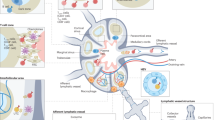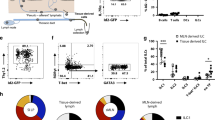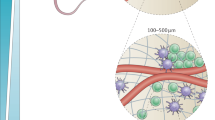Abstract
GRISCELLI et al. have demonstrated1 the existence of two populations of lymphoblasts with distinct migratory characteristics in the rat. One population was obtained from the mesenteric lymph nodes which migrate to the lamina propria of the small intestine and the other from peripheral lymph nodes which failed to migrate to the gut but were found in the spleen. These observations have been confirmed subsequently in the mouse2–5 and in the sheep6. In mice the different migratory patterns of lymphoblasts of mesenteric or peripheral origin were shown to operate at the level of the T lymphoblast5. We have investigated whether this dichotomy extends to the migration of 51Cr-labelled small T lymphocytes and have found that less than 2% of the injected small T lymphocytes localise in the small intestine (excluding Peyer's patches) and that mesenteric and peripheral small T cells migrate equally well through mesenteric, peripheral lymph nodes and Peyer's patches. There is a slight but consistent tendency for mesenteric T cells to localise more in the liver and less in the spleen than peripheral T cells. We conclude that the distinctive migration which characterises lymphoblasts in mice does not apply to small lymphocytes.
This is a preview of subscription content, access via your institution
Access options
Subscribe to this journal
Receive 51 print issues and online access
$199.00 per year
only $3.90 per issue
Buy this article
- Purchase on Springer Link
- Instant access to full article PDF
Prices may be subject to local taxes which are calculated during checkout
Similar content being viewed by others
References
Griscelli, C., Vassali, P. & McCluskey, R. T. J. Exp. Med. 130, 1427–1451 (1969).
Guy-Grand, D., Griscelli, C. & Vassalli, P. Eur. J. Immunol. 4, 435–443 (1974).
Parrott, D. M. V. & Ferguson, A. Immunology 26, 571–588 (1974).
McWilliams, M., Phillips-Quagliata, J. M. & Lamm, M. E. J. Immunol. 115, 54–58 (1975).
Rose, M. L., Parrott, D. M. V. & Bruce, R. G. Cell. Immunol. 27, 36–46 (1976).
Hopkins, J. & Hall, J. G. Nature 259, 308–309 (1975).
Freitas, A. A. & de Sousa, M. Eur. J. Immunol. 5, 831–838 (1975).
Julius, M. H., Simpson, E. & Herzenberg, L. A. Eur. J. Immunol. 3, 645–649 (1973).
Tse, H. & Dutton, R. W. J. Exp. Med. 143, 1199–1210 (1976).
Cahill, R. N. P., Poskitt, D. C., Frost, H. & Trnka, Z. J. Exp. Med. 145, 420–428 (1977).
Sprent, J. Cell. Immunol. 21, 278–302 (1976).
Tilney, N. L. J. Anat. 109, 369–383 (1971).
Author information
Authors and Affiliations
Additional information
to whom reprint requests should be sent: Chester Beatty Research Institute Fulham Road, London SW3, UK
Rights and permissions
About this article
Cite this article
DE FREITAS, A., ROSE, M. & PARROTT, D. Murine mesenteric and peripheral lymph nodes: a common pool of small T cells. Nature 270, 731–733 (1977). https://doi.org/10.1038/270731a0
Received:
Accepted:
Published:
Issue Date:
DOI: https://doi.org/10.1038/270731a0
Comments
By submitting a comment you agree to abide by our Terms and Community Guidelines. If you find something abusive or that does not comply with our terms or guidelines please flag it as inappropriate.



